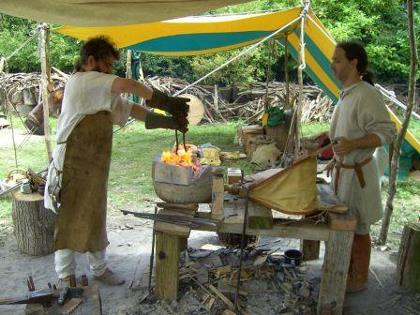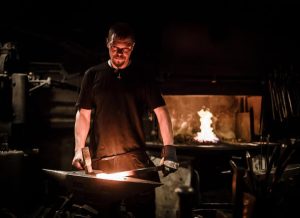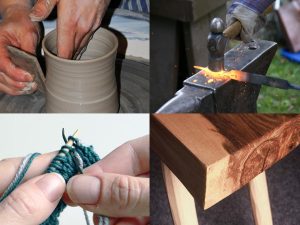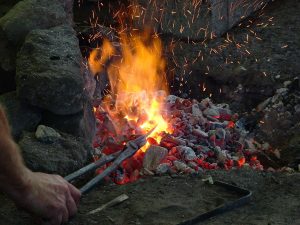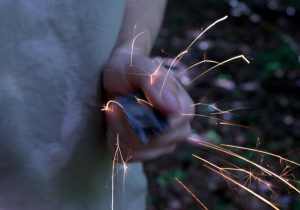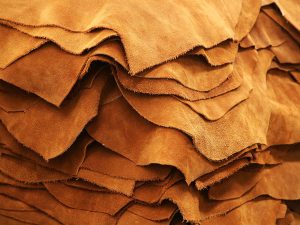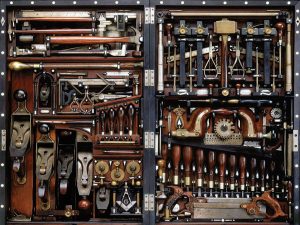In this post we learn from Cormac Stanton how to construct a pair of working bellows, be they for the fireplace or the forge. A member of the Manaraefan Herred Dark Age and Early Medieval re-enactment group, as Kormak the Carter he works alongside blacksmith Mo Swinhosson. Both are described as highly competent early medieval technicians and can fix almost anything, especially if you can hit it with a hammer! It’s over to Cormac from here with his step by step guide.
This is hopefully the start of a set of documents that will help in the construction of a portable, authentic forge and bronze casting set up. I am starting with the bellows as I can use them at home to help get the fire going in the winter months. I have repaired a number of sets of bellows, but this is the first set I have actually made myself from scratch. They appear to work well – good flow rate, nice range of movement, practically no air loss. If you follow any of the instructions below and it doesn’t work properly – well then you are just doing it wrong.
All relevant safety equipment should be used without compromise and supervision sought from a suitably trained source before operating any tool.
Costings
- Leather £40
- Wood 6m 9”x1” £20
- Length 9mm dowel £1.99
- 25mm tacks £2 – used around 100 tacks per set
- 12mm tacks £0.65 – only used a handful near the nozzle
- Oil for wood (used cooking oil so really cheap)
- 28mm copper tubing 6”, scrap material
- Glue/sandpaper/jigsaw blades
- Waxed linen thread
Total for both sets was around £65.00
Tools
- Pencil
- Ruler
- Dinner plate drawing for curves
- Several newspapers and low tack masking tape
- Scissors
- Stanley knife
- Panel saw
- Jigsaw
- Hammer
- Belt sander – cheap >£20 from B&Q model with free orbital sander – paid for itself on this job alone.
- Power Drill (9.5mm for dowels, 30mm and 26mm flat-bits for nozzle hole.
- Sash cramps
- Assorted clamps
- Water resistant PVA wood glue
- Sewing awl and leather needles
- Leather hold punch – for holes for hinge to go over dowels
It took about the spare over 2 weeks to make both sets of bellows – realistically allow about two full days per set.
The Bellows
Figure 1 shows the wooden panels for the top and bottom of a set of bellows. These ones were 18” across at the widest point, and also 18” from the front edge of the handles up to the block that will hold the nozzle.

Figure 1. Top and bottom panels.
There are quite a few shapes around, some with the handles as separate components etc. The choice you make is dependent upon the era you are portraying. It does take a lot of leather to make the bellows, so if cost is a consideration, then you will either need to look for a different material, or scale things down quite a bit. Both of these panels were made by pegging and gluing 9”x1” pine planning together (oak would have been better, but I too was working to a budget). It took practically all of a 3m plank to make each set of bellows, and the material was chosen as carefully as possible so that all the knots were missed during the cutting out. Newspaper templates were used quite a bit throughout the design and construction, and also in the shop when choosing the wood. The planks did have quite a number of knots in them – it’s just I managed to miss them all with minimal wastage.
The join between the planks needs to be airtight, so good glue, and clamping them tightly is essential. The nozzle block is three panels laminated together and pinned with two dowels. The re-enforcer bar at the handle end is pegged and glued, but the one at the nozzle end will not be attached until the hinge has been made and sandwiched in place. Those re-enforcers are shaped using the power sander to give them a more natural shape. All the extra pieces were made from the odd shapes cut out when cutting the panels for the top and bottom boards. There is quite a big gap required for the seal and the hinge (around 10mm), so the top board needs to be that much shorter. Details of that are shown later. The nozzle was drilled in two stages, down to about half way with a 30mm flat-bit, and then on with a 26mm flat-bit to give a step which will stop the tube vanishing up inside. The back of the hole has been opened up a little with a knife to help the airflow.

Figure 2. Valve – inside view.
The valve, Figure 2, is just a piece of leather nailed in place along one edge. The nails line up with the re-enforcer on the other side. I have used a number of different length ‘carpet’ tacks throughout the build, 12mm and 25mm. I’ve always used the longest ones I can get away with, being careful not to split the wood by putting too many long tacks close together in any group or go through with them. The valve is held in place with 25mm tacks because of the extra thickness with the re-enforcing bar behind. There is about an inch and a half overlap of leather around the valve, and another strip has been run along the fixed edge to help keep everything in place. With use and age, the valve will become softer. You will note that the valve will be in the bottom face of the bellows. This will mean that it will close under gravity and the bellows will be that much more efficient because of this. The re-enforcer bar will hold the bellows up enough to let the air come up through the valve.

Figure 3. Valve shown through the bottom board.
The leather used was soft buckskin leather. As you can see from Figure 4, there is quite a bit in each set of bellows, because I was trying to save on the cutting out, two pieces need to be sewn together to get the size required. That piece is about 60” long and 18” at the widest point. The seam was double stitched and with the leather folded together to make a gas tight seam. The shape was determined by pinning plastic in place first to test the design; I used a heavy duty polythene refuse sack. Each piece is long enough to go from the centre of the handle right round and fully across the block that holds the nozzle. The width at the middle was 17”, as this allowed the bellows to open to slightly over 45º. With the size of the bellows, this gave a comfortable amount of movement when operating them. Too much leather, and the sides just balloon out when you close them – big forge bellows sometimes have retaining rings in place to stop this happening. The width of the leather at the thin ends is such that it will allow the top board to be nailed in place once the seal is made properly – see later.

Figure 4. Leather required for the bellows.
The leather is attached at the handle end first, see figure 5, making sure that the seam runs vertically. I am using a strip of thicker leather that serves to hold the more flexible buckskin leather in place and help keep a gas tight seal between the nail fixings.

Figure 5. Attaching the leather at the handles end first.
The leather brought around the bellow – not to tightly- and is folded and pinned at the nozzle end. It is not worth pinning all the way around just yet in case things don’t line up properly. Figures 6 and 7 show how the leather is folded and attached in place. I have used 12mm tacks in all but the points at which stress on the leather will occur to save splitting the wood. Where the leather is pulled across the handles will need to be sealed later. This will be done with glue and 12mm tacks. You can clearly see the three laminated pieces which make up the nozzle block – I should have turned the middle piece around to make it less noticeable and matched the grains.

Figure 6. Folding the leather round and making the seal at the nozzle block

Figure 7. Sealing the leather to the nozzle block with tacks – note the larger headed tack at the 11 O’clock position is 25mm, the rest are 12mm – it is under more stress than the rest.
The other side is also brought around and pinned in place (see Figures 8 and 9). The hole is cut clear and a few more pins are put in place to keep everything where it should be. You will notice that the leather is quite a bit higher than the nozzle block. This is important as you need to have enough movement in the hinge without stressing the seal.

Figure 8. Both ends of leather crossed over and sealed against the nozzle block.

Figure 9. Note that the leather does not stop at the top of the nozzle block.
Two blocks are fixed in place on the inside of the bellows on either side of the hole, far enough back so as not to obstruct the hinge, edges of the leather or the flow (see Figure 10). The edges have been rounded off to prevent any wear on the leather if it does come in contact with them. The blocks were glued down and held in place with a screw each – this is not going to be visible from the outside. These will support the top board in place when the bellows are closed, thereby stopping the hinge being stressed if weight is applied during transit.

Figure 10. Blocks to support top board to stop excess stress on hinge
Figure 11 shows the top board in place. The leather was attached at the handles end first, the same as earlier, and then the leather was brought around and attached at the front. The excess leather will drop down below the hinge in a ‘N’ shape and form a flexible seal as shown in Figure 12.

Figure 11. Front of bellow is now properly sealed. Top board drops down to same height at nozzle block.
At this stage the bellows will work (see Figure 12), although they will leak like anything. With the bellows open, I have added a couple more pins. I have tried to make sure that the leather all becomes taught at the same point when they are opened fully. Before putting the leather strips in place (at least on the second set of bellows) I marked up inch intervals all down the leather. This made things quicker during the assembly and kept everything looking nice and neat. Being happy that the leather looks right, I have added more pins to hold it in place, and have cut away the excess leather.

Figure 12. Bellows will ‘work’ but will leak.
The hinge is now ready to put in place. With the bellows closed note the 10mm gap required to between the nozzle block and the top board (Figure 13). I made up a cardboard template for the hinge. This was set over the pegs and tested before a leather one was cut. I used the same thickness leather as for the valve as this needs to last.

Figure 13. Ready to take the leather hinge.

Figure 14. Leather hinge is sandwiched into place.
With the hinge in place (see Figure 14) I placed the two retaining plates in place sandwiching the leather in place. The dowels holding the plates have been glued into position. The leather has been glued top and bottom and everything was clamped in place. A couple of pins were also put through the leather between the dowels just for good measure. The blocks that were put in place earlier are keeping the top of the bellows at the same height as the nozzle block. Hopefully this will help the hinge last a little longer as it will not be under stress – especially when things are packed on top of them in the car. The nozzle was a short length of 28mm copper water-pipe that had leather wrapped around it to form a tight seal (off-cuts from earlier were used) This was just pushed in place. The copper tube will not be used to go into the fire at all. A ceramic tu-iron will be made up instead.

Figure 15. Nozzle fitted in place with leather seal.

Figure 16. Both bellows working together.
The bellows are supposed to work in pairs (see Figure 16), with one blowing whilst the other one is coming up. This stops the coals from the forge being sucked back into the bellows. With a bit of practice a constant steady flow of air can be achieved. This is far better for the fire, and takes considerably less time and effort if you want to go up to welding heat. Inside that leather tube is copper tubing to keep everything open. I need to work on a better solution as with just the leather in place, the flow rate gets really slowed by the seams.
With thanks to Cormac Stanton and friends at Manaraefan Herred for their kind permission to reproduce this article with images from the original article available here.

